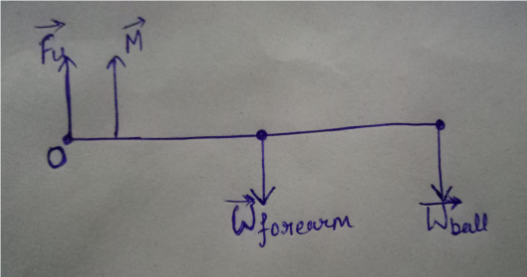A man holds a 164-N ball in his hand, with the forearm horizontal (see the figure). He can support the ball in this position because of the flexor muscle force M, which is applied perpendicular to the forearm. The forearm weighs 23.7 N and has a center of gravity as indicated. Find (a) the magnitude of M and the (b) magnitude and (c) direction (as a positive angle counterclockwise from horizontal) of the force applied by the upper arm bone to the forearm at the elbow joint. Upper arm bone- Elbow joint J 1 1 0.0510 mT I I M Flexor muscle- 0.0890 m 0.330 m-
A man holds a 164-N ball in his hand, with the forearm horizontal (see the figure). He can support the ball in this position because of the flexor muscle force M, which is applied perpendicular to the forearm. The forearm weighs 23.7 N and has a center of gravity as indicated. Find (a) the magnitude of M and the (b) magnitude and (c) direction (as a positive angle counterclockwise from horizontal) of the force applied by the upper arm bone to the forearm at the elbow joint. Upper arm bone- Elbow joint J 1 1 0.0510 mT I I M Flexor muscle- 0.0890 m 0.330 m-
College Physics
11th Edition
ISBN:9781305952300
Author:Raymond A. Serway, Chris Vuille
Publisher:Raymond A. Serway, Chris Vuille
Chapter1: Units, Trigonometry. And Vectors
Section: Chapter Questions
Problem 1CQ: Estimate the order of magnitude of the length, in meters, of each of the following; (a) a mouse, (b)...
Related questions
Question

Transcribed Image Text:**Problem Description:**
A man holds a 164-N ball in his hand, with the forearm horizontal. He can support the ball in this position because of the flexor muscle force \( \vec{M} \), which is applied perpendicular to the forearm. The forearm weighs 23.7 N and has a center of gravity as indicated.
**Tasks:**
- (a) Find the magnitude of \( \vec{M} \).
- (b) Find the magnitude and
- (c) direction (as a positive angle counterclockwise from horizontal) of the force applied by the upper arm bone to the forearm at the elbow joint.
**Diagram Explanation:**
- A skeletal forearm is shown horizontally with a hand holding a ball.
- The forces acting are indicated with arrows:
- **Flexor Muscle Force \( \vec{M} \):** Shown as a blue arrow perpendicular to the forearm, pointing upwards.
- Important measurements:
- The distance from the elbow joint to the point of application of \( \vec{M} \) is 0.0510 m.
- The distance from the elbow joint to the forearm's center of gravity is 0.0890 m.
- The distance from the elbow joint to the point where the ball is held is 0.330 m.
This setup highlights the mechanics of balancing torques around the elbow joint to maintain the horizontal position.
Expert Solution
Step 1: Draw the free-body diagram of the forearm.
No force is acting along the horizontal. Thus, the force by the upper arm bone to the forearm will be along the vertical direction. Thus, consider that the force is acting in an upward direction.
Draw the free-body diagram of the forearm.

Step by step
Solved in 5 steps with 5 images

Knowledge Booster
Learn more about
Need a deep-dive on the concept behind this application? Look no further. Learn more about this topic, physics and related others by exploring similar questions and additional content below.Recommended textbooks for you

College Physics
Physics
ISBN:
9781305952300
Author:
Raymond A. Serway, Chris Vuille
Publisher:
Cengage Learning

University Physics (14th Edition)
Physics
ISBN:
9780133969290
Author:
Hugh D. Young, Roger A. Freedman
Publisher:
PEARSON

Introduction To Quantum Mechanics
Physics
ISBN:
9781107189638
Author:
Griffiths, David J., Schroeter, Darrell F.
Publisher:
Cambridge University Press

College Physics
Physics
ISBN:
9781305952300
Author:
Raymond A. Serway, Chris Vuille
Publisher:
Cengage Learning

University Physics (14th Edition)
Physics
ISBN:
9780133969290
Author:
Hugh D. Young, Roger A. Freedman
Publisher:
PEARSON

Introduction To Quantum Mechanics
Physics
ISBN:
9781107189638
Author:
Griffiths, David J., Schroeter, Darrell F.
Publisher:
Cambridge University Press

Physics for Scientists and Engineers
Physics
ISBN:
9781337553278
Author:
Raymond A. Serway, John W. Jewett
Publisher:
Cengage Learning

Lecture- Tutorials for Introductory Astronomy
Physics
ISBN:
9780321820464
Author:
Edward E. Prather, Tim P. Slater, Jeff P. Adams, Gina Brissenden
Publisher:
Addison-Wesley

College Physics: A Strategic Approach (4th Editio…
Physics
ISBN:
9780134609034
Author:
Randall D. Knight (Professor Emeritus), Brian Jones, Stuart Field
Publisher:
PEARSON